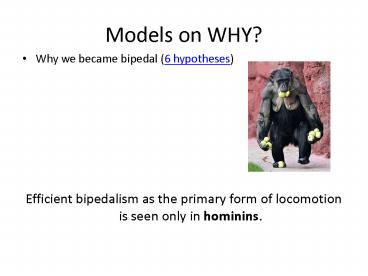Models on WHY? - PowerPoint PPT Presentation
Title:
Models on WHY?
Description:
Models on WHY? Why we became bipedal (6 hypotheses) Efficient bipedalism as the primary form of locomotion is seen only in hominins. Origins of all these bipedalism ... – PowerPoint PPT presentation
Number of Views:52
Avg rating:3.0/5.0
Title: Models on WHY?
1
Models on WHY?
- Why we became bipedal (6 hypotheses)
- Efficient bipedalism as the primary form of
locomotion is seen only in hominins.
2
Origins of all these bipedalism tendencies?
3
Primate Evolution
- Where all the humans, australopithicines,
monkeys, apes, homo habilis, tarsiers, lorises,
bush babies, Neandertals, hobbit humans, etc.
came from - Millions of years ago right after the dinosaurs
died
4
The end of the Cretaceous period 65.5 mya
5
Paleocene 65 myaPlacental mammal radiation
- Earliest primates
6
Eocene 55-35mya
- More than 200 recognized fossil primate species.
7
Eocene 55-35 mya
- More than 200 recognized fossil species.
Darwinius, from the Messel site in Germany,
discovered in 2009 and dates to 47 mya.
8
Eocene Primates
- Foramen magnum position whether the body is
habitually horizontal (like a horse) or vertical
(like a monkey). - During the Eocene, the foramen magnum in some
primate species was beginning to move from the
back of the skull towards the center. - SuggestingHolding their bodies erect while
hopping and sitting, like modern lemurs, galagos,
and tarsiers.
Eocene Era primate and modern human skulls
9
Oligocene
- Rafting Africa-gt South America 34 mya early in
the Oligocene - By this early point in the Oligocene, continental
drift had separated the New World from the Old
World. - New and Old World monkeys branch off here, 35
million years ago.
10
Oligocene
- Approximate position of the continents during the
beginning of the Oligocene
11
Oligocene Primates from Fayum
- Apidium
- Primitive dental arrangement suggests near or
before evolutionary divergence of Old and New
World anthropoids - Small, squirrel-like fruit and seed eating, adept
at leaping and springing
Walking with the Beasts (BBC) Whale Killer
12
Egypts Fayum
- Today, its a 550 square mile lush oasis basin
in the desert south of Cairo - During the Eocene and Oligocene, the Faiyum was
forrested - At the beginning of the Miocene, the Faiyum had
become a dry hollow
13
Oligocene Primates from Fayum cont.
- Aegyptopithecus (genus)
- 35-33 mya
- Largest of Fayum anthropoids, roughly the size of
a modern howler monkey (13-18 lbs) - Short-limbed, slow-moving































